Project Subtitle:
Project Description:
Viridescent Building
Maine's First Net Positive Passive House - Falmouth, Maine
TideSmart Global is an experiential marketing company in Falmouth, Maine that is committed to investing in the future of its employees, its community, and the sustainability of the natural environment. When it came time to replace a small residential structure on their campus, they wanted a new building that would meet the highest of energy efficiency standards (Passive House) and serve as an example for the building industry in Maine and beyond.
The result is a certified Passive House that generates far more than twice the energy it consumes, making it significantly net positive with zero emissions. This is achieved by dramatically reducing the building’s energy demand and installing copious amounts of renewable energy in the form of a 19.4 kW solar array that occupies the entire roof. This “extra” power is used to power a vehicle charging station (that is free for public use) and to offset power consumed by other existing buildings on TideSmart’s campus.
Viridescent’s design is founded on passive solar design principles, orienting the building and configuring the fenestration to maximize solar heat gain in the winter and minimize it in the summer. It features a highly insulated and tightly-sealed exterior thermal envelope consisting of vapor-open Larsen truss walls (20” thick filled with dense-packed cellulose), a frost protected slab (8” of polished concrete over 10” of EPS insulation), European triple pane tilt turn windows, and detailed connections that are tenaciously sealed and thermally isolated from the exterior. It also features resource efficient, highly durable, low emitting materials, LED lighting, water efficient fixtures, an energy monitoring system.
Being located in a commercial zone, it was also important for this “home” to be flexible enough to be used as an office. It is currently occupied by Tidesmart as an office, but with a few small modifications, it can easily be used as a two bedroom house.
Building Type Summary:
Address:
Elevation:
Lat. / Long.:
Location Type:
Köppen Climate Type:
Climate Region:
Solar Insolation:
Annual HDD :
Annual CDD:
HDD Base Temp:
CDD Base Temp:
Occupancy Type and Details:
This building is owner occupied. While the building was designed as a house, it is being used as an office. There are currently 10 full time work stations a part time (or visitor's) work station and a reception desk that currently is unoccupied. There are currently 9 full-time workers employed in the building and work on typical business calendar days from 8:30 to 5:00. They are the creative department of a marketing company so it is not uncommon for the occasional employee to work a couple of hours extra in a day.
Conditioned Floor Area:
Conditioned Building Volume:
Semiconditioned Floor Area:
Unconditioned Floor Area:
Multiple buildings?:
Total number of units in project (all buildings):
Total floor area of project (all buildings):
Historic?:
Completion date:
Site description:
This is a new building built on the site of a demolished house. The existing home that was demolished was part of a larger piece of property that is zoned as "Commercial". The demolished home was, therefore, a nonconforming structure in that it had a residential use in a commercial zone. Furthermore the house set well inside the setbacks with which any new commercial construction would have to comply. It was therefore decided by the owner to replace the demolished home with a new building that could function as either a residential structure or a small commercial office building. The new building was therefore designed primarily as a house so that it could remain within the setbacks. Presently, all certifications and modeling of the building are of a residential home. It should be known, however, that the building is currently being used and monitored as an office building occupied by 9 employees. The site is in a suburban setting on the border of a commercial and residential zone. It sits on an elevated site adjacent to a well traveled road.
Materials:
Exterior:
--The wood siding is Cambia (a torrified poplar) (http://www.cambiawood.com/) . Local hardwood is kiln fired at high temperatures (500 degrees F approximately) in an oxygen-free environment so that the wood cant ignite. The smoke and gasses that are produced from this process are captured and ignited to power the kiln reducing the energy consumption of production. (The wood is from Maine and the process is in neighboring NH).
--Nichiha fiber cement siding (http://www.nichiha.com/products/detail-dev/architecturalblock). It is manufactured from a pressed, stamped, and autoclaved mix of Portland cement, fly ash, silica, recycled rejects, and wood fiber bundles. It has one of the higher pre-consumer recycled content of the available fibercement products at 25% for fly ash and 15% for a total 40% by weight.
--Trim is Boral Truexterior. It is a polymerized fly ash composite product. (http://www.boralamerica.com/truexterior) It is 70% pre-consumer recycled fly ash and is cradle to cradle certified (silver). It is hichly durable and rot resisitant.
---Insulation: The majority of the building's above grade insulation is dense packed cellulose, which is recycled newsprint treated with a borate. 13,000 pounds of cellulose were installed in this building.
--The frost protected slab minimizes the use of concrete in lieu of large amounts of type 9 EPS rigid foam insulation. EPS has a lower global warming impact than its more frequently used cousin XPS.
Interior:
--The finish on the first floor is polished concrete. (No added materials beyond the densifyer).
--The second floor finish is local white oak that has been stained with "Black Magic" (white vinegar and steel wool that has been stored in a 5 gallon bucket for 48 hours. After being applied the wood turns charcoal gray) it was then finished with three coats of poly whey (PolyWhey Floor finish is an evolved clear coating that uses recycled whey protein to make a durable and safe sealer and topcoat in one) http://www.vermontnaturalcoatings.com/our-products/polywhey-natural-floo...
--The interior doors are urea-formaldehyde free doors from Masonite's Safe-n-sound series. (https://www.masonite.com/pdf/architecturalSpecs/TechnicalSpecSheet-1-3-8...) The are 54% pre-consumer recycled content, and 46% rapidly renewable content by weight.
--The interior running trim is all local poplar.
--All interior paints are zero VOC
--Cabinetry is from Executive Cabinetry and contains no added urea formaldehyde and is Greenguard certified at a gold level (http://www.executivecabinetry.com/)
--The counter top in the kitchen is Richlite (http://www.richlite.com/northwest/) is made from recycled paper and paper pulp in a nonphenolic resign and has a minimum recycled content of 50%
Energy Highlights:
--Passive solar design principles (southern glazing, shading devices, high performance triple pane windows, thermal mass)
--Ductless mini-split heat pumps with hyper heat
--Air Pohoda iERV (90% efficient with air-flow variability within the core with an ERV filter and an HRV filter available). It also comes with its own web portal that reports fan speed, incoming air temperature, exhausting temperature, and humidity for both in coming and exhaust air.
--very compact plumbing core
--Combustion free, zero emissions building.
--19.4 KW PV solar array
--EV charging station available to the public.
--All LED lighting
LCA Description:
LCA was not used
HERS Index:
Annual renewable energy generated:
Electric Utility Company:
Gas Utility Company:
Datasets and Utility Bills sources and reliability:
This building will begin tracking its energy usage circuit by circuit at the beginning of 2016 with an energy monitoring system. It will be highly reliable and accurate. We plan to make this information available to NESEA and it will be updated monthly within the first year, quarterly within the second year, and annually thereafter.
Electricity amount (imported from grid):
Natural gas amount (purchased energy):
Subslab assembly:
Frost protected slab comprised of 8" of type 9 RPS rigid foam. A CAD file was sent to Avilite Corp of New Hampshire with the profiles of the frost protected slab insulation/formwork. Once installed, an 8" reinforced concrete slab was poured over a reinforced polyethelene vapor barrier, over the 10" thick EPS insulation. The slab edge is protected behind 8" of EPS. A tapered horizontal bib extends 3'-0" beyond the footprint of the building protecting the sub soils from frost.
Slab edge assembly:
The slab edge is protected behind 8" of EPS. A tapered horizontal bib extends 3'-0" beyond the footprint of the building protecting the sub soils from frost. The reinforced Polyethelene vapor barrier wraps up and over the slab edge insulation and is taped to the exterior air sealed weather resistant barrier.
Foundation wall assembly:
none
Above grade wall assembly:
Vapor-Open Larsen Truss walls: The walls are first constructed as simple 2x4 stud walls with Zip System sheathing. The sheathing becomes both the primary air sealing layer and the vapor control layer (class II vapor retarder). Then 11 7/8” wood I-joists are fastened on the outside vertically and wrapped with a WRB that acts as the building’s secondary air control layer. The I joist cavity is filled with dense-packed cellulose (high recycled content, low embodied energy, low global warming impact, low emittance). Then a ventilation rain screen is installed followed by siding.
Sheathing layers (air sealing and vapor control layers) are on the warm side of the assembly eliminating the risk of condensation and mildew for the life of the building.
Door Area:
Space heating - Manufacturer & Model:
Space heating - capacity:
Space cooling - Manufacturer & Model:
Space cooling - capacity:
Domestic hot water - Manufacturer & Model:
Domestic hot water - capacity:
Domestic hot water - efficiency:
Ventilation - Manufacturer & Model:
Other Software tools:
Revit 2015
Energy Modeling Software:
WUFI Passive 3.0
Total Cost of Project:
Construction hard cost:
Gross Cost of Renewable Energy System:
Value of Tax Credits for renewable energy systems:
Net Cost of renewable energy systems:
Federal incentives:
30% renewables rebate
State incentives:
none
Local incentives:
none
Utility incentives:
net metering
Published References:
http://portlandphoenix.me/2015/06/17/features/newest-tidesmart-building-...
http://www.prnewswire.com/news-releases/tidesmart-global-opens-first-net...
http://www.themainemag.com/store/detail/6-maine-homedesign/flypage/741-d...
http://briburn.com/briburn-content/uploads/2013/04/2014-TideSmart-provid...
Special architectural measures:
• Passive House Design Standards
• Substantial Renewables. Net Positive (19.4 kW array, generates roughly twice what it consumes)
• Vapor-open wall (Larsen truss wall) and roof assemblies.
• Frost protected 8 inch thick polished concrete slab provides substantial thermal mass.
• Triple pane European tilt-turn windows (u=0.088, SHGC=0.5) create tightly sealed, well insulated portals for natural daylight and solar energy.
• Passive solar design (orientation, fenestration, thermal mass, and shading) provide the primary means of thermal comfort and financial efficacy.
• Energy Modeling with WUFI Passive
• Hygrothermic Modeling of assemblies (also with WUFI Passive) to ensure resiliency and durability.
• Tightly sealed and tested. (0.54 ACH50)
• 90% efficient iERV (combination ERV and HRV) to ensure a high level of indoor air quality while maintaining energy efficiency.
• High efficiency Ductless Mini-split heatpumps.
• Water conserving plumbing fixtures (water sense and dual flush toilets)
• 100% LED lighting
• Resource-efficient finishes, materials and products (i.e. zero VOC paints, UFF millwork and doors, torrified local hardwood siding, local FSC oak flooring finished with vinegar and steel wool or “black magic” and polywhey)
• Performance Tested by RESNET, Zero Energy Homes, and PHIUS Rater
• Energy Modeling installed to monitor building’s performance
Energy Strategies:
The basic energy strategies for this building common tried and true practices for passive houses and Net zero buildings everywhere:
--Reduce energy demand by employing passive solar principles witha simple volume (and with high performing windows)
--Reduce demand by designing a robust, high-performance building envelope (very tightly sealed and very well insulated)
--Reduce the size of the mechanical system, and use a highly efficient mechanical system to provide heating and cooling.
--Provide a balanced ventilation system.
--Provide renewable energy to provide for the remaining building energy needs.
Energy Use and Production Documentation:
Subslab R-value:
Slab edge R-value:
Above grade wall R-value:
Average window U-factor:
Solar Heat Gain Coefficient:
Visible Light Transmittance:
Door U-Factor:
Cost per square foot of Conditioned Space:
Air Changes per hour, ACH50:
Project Photos:
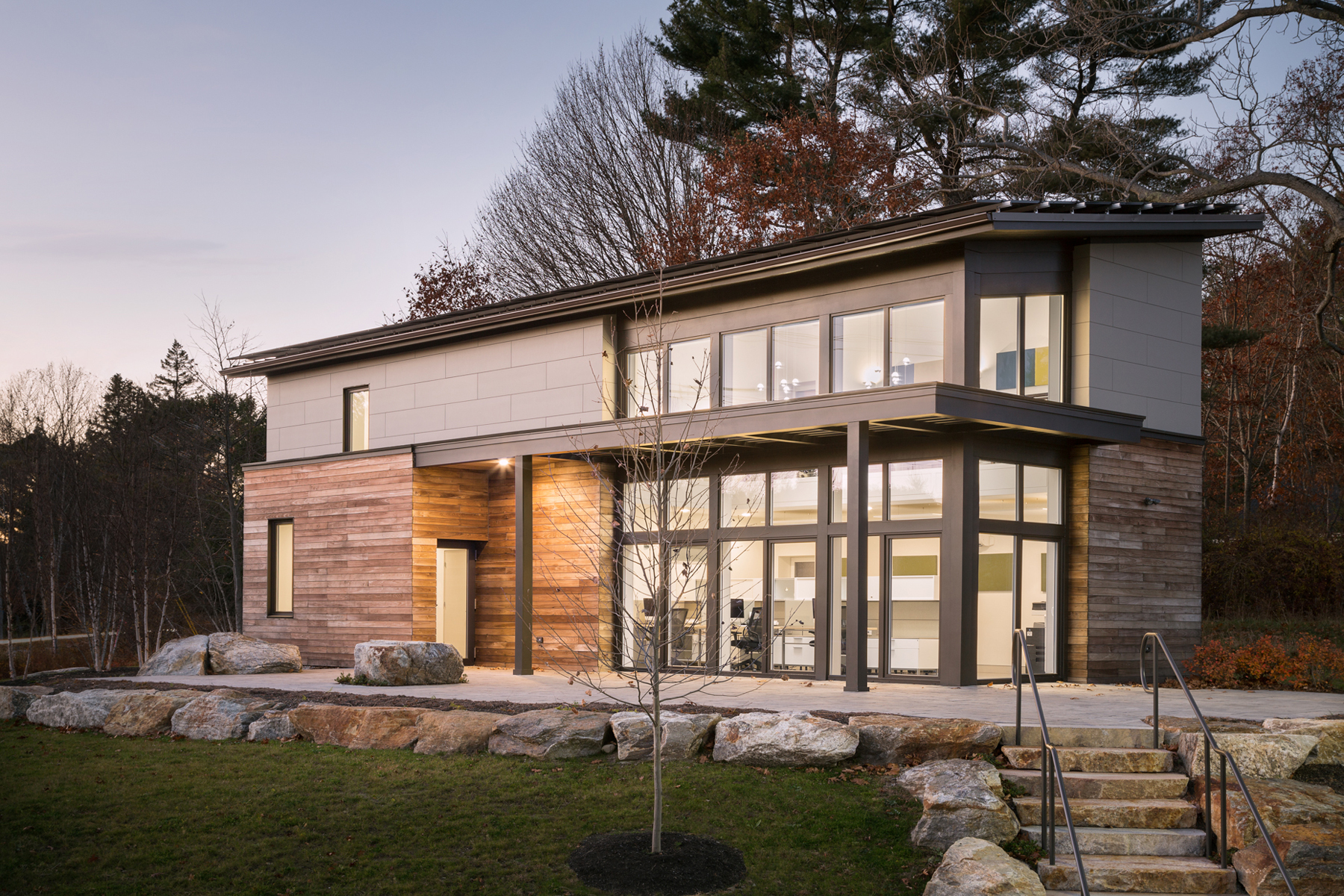
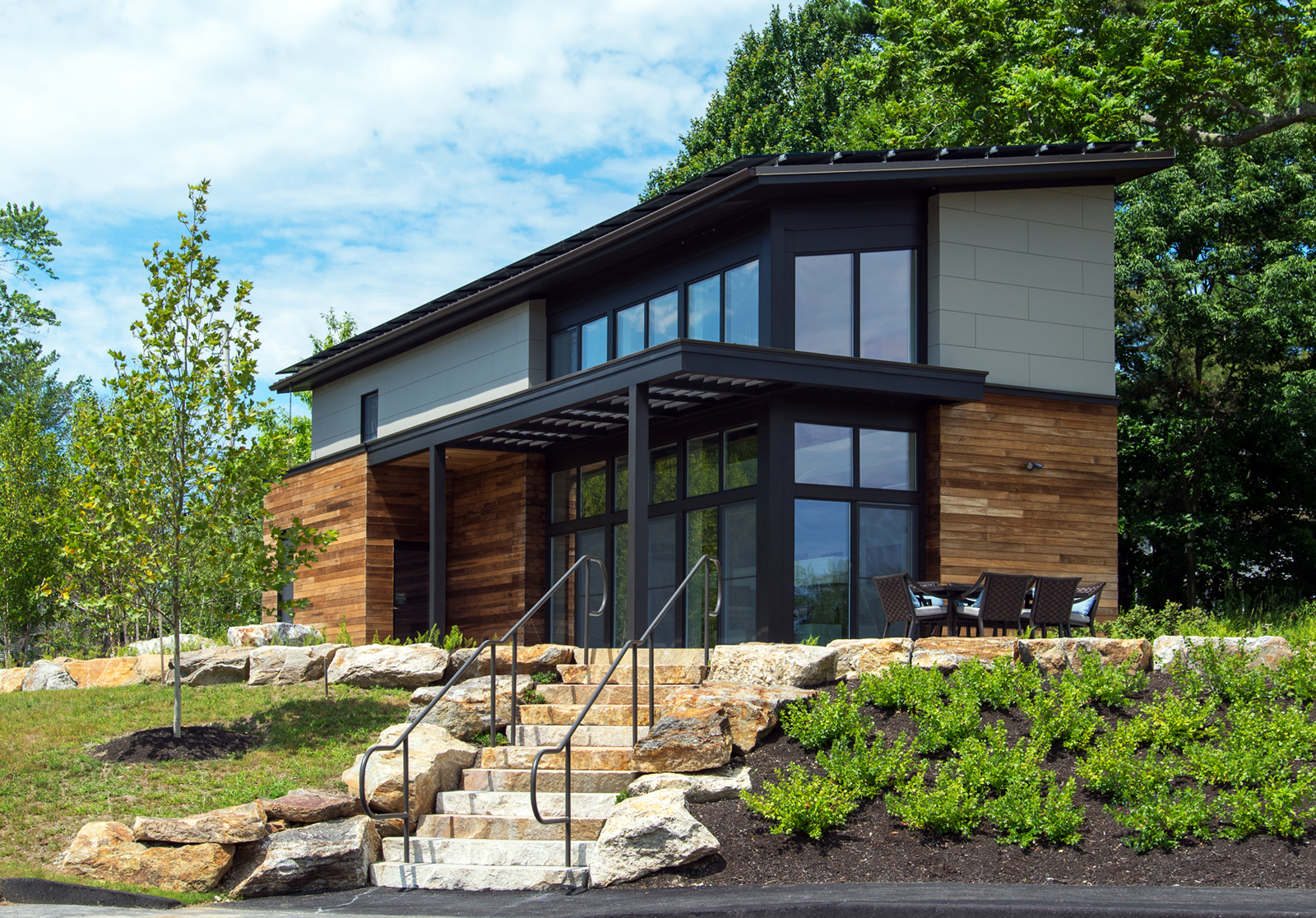
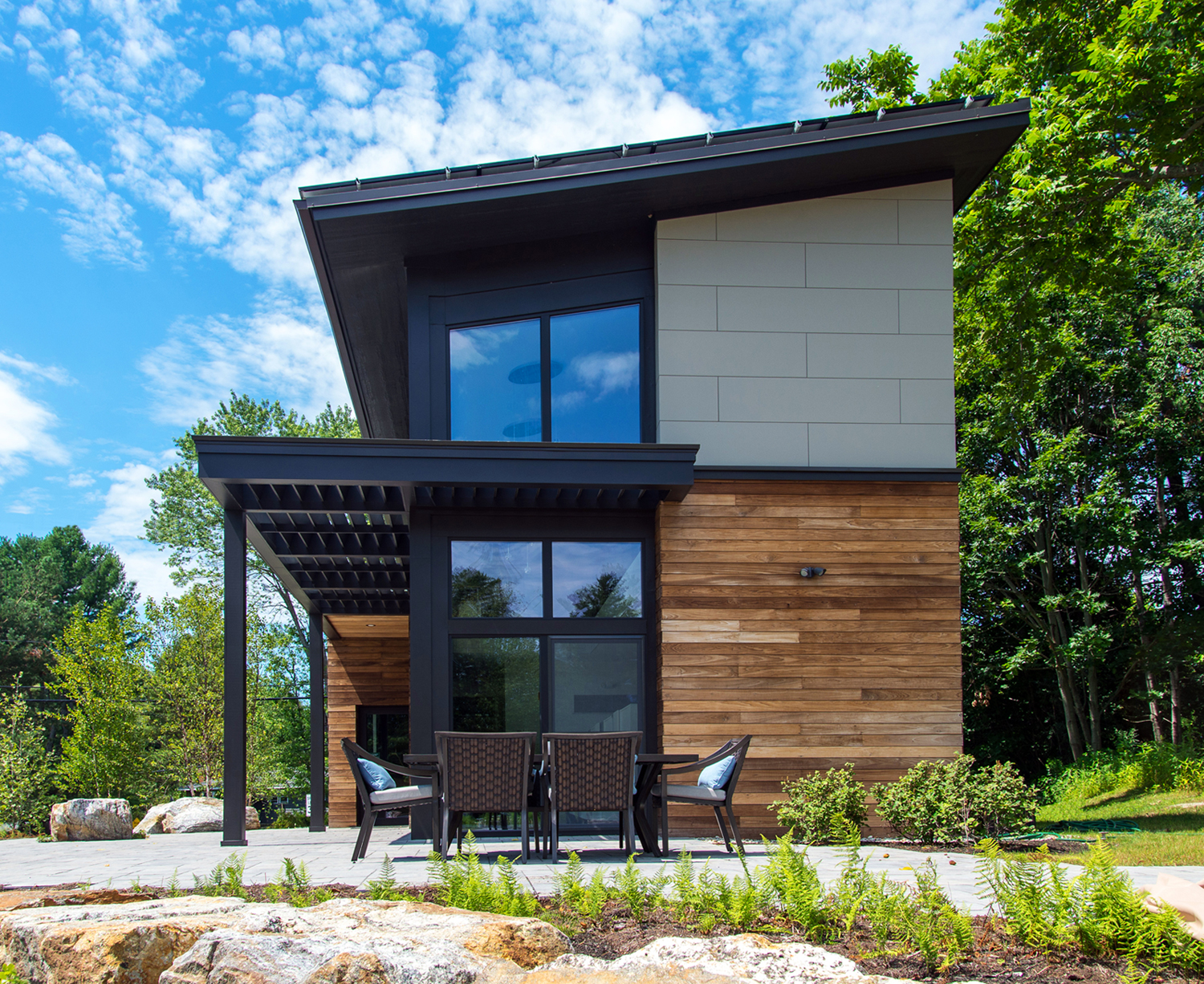
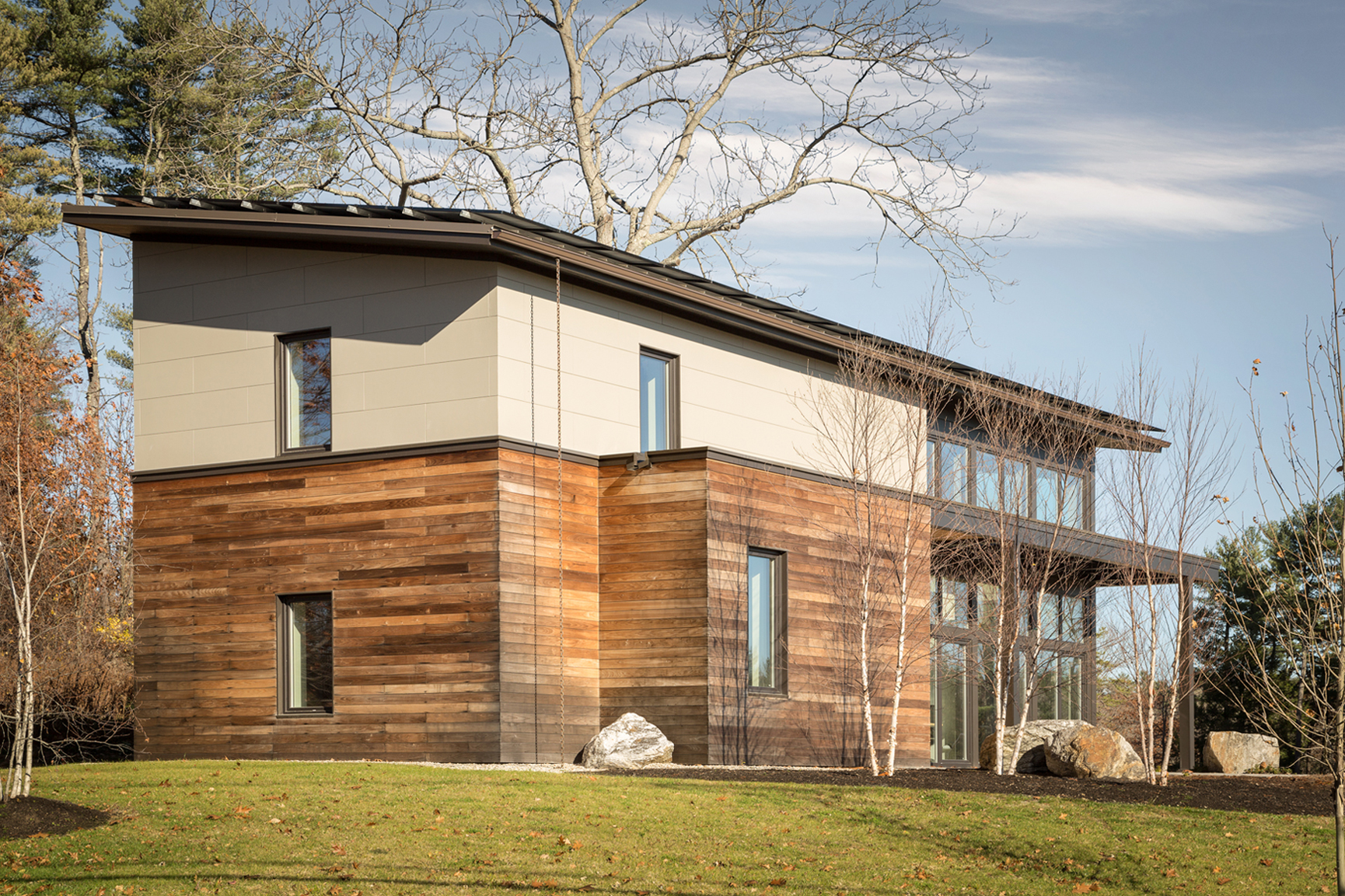
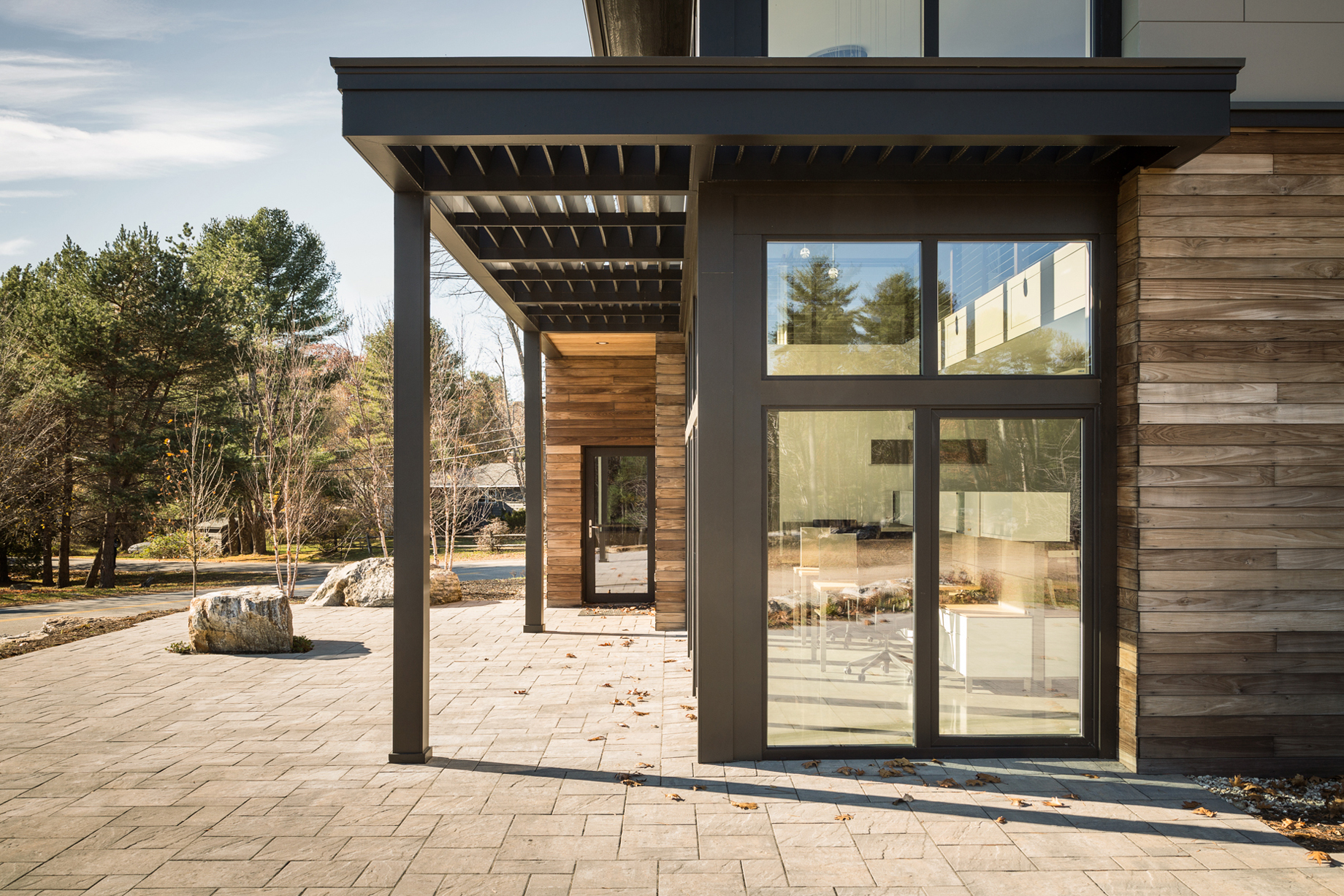
Number of Bathrooms:
Scope Description:
This is a new building built on the site of a demolished house. The existing home that was demolished was part of a larger piece of property that is zoned as "Commercial". The demolished home was, therefore, a nonconforming structure in that it had a residential use in a commercial zone. Furthermore the house set well inside the setbacks with which any new commercial construction would have to comply. It was therefore decided by the owner to replace the demolished home with a new building that could function as either a residential structure or a small commercial office building. The new building was therefore designed primarily as a house so that it could remain within the setbacks. Presently, all certifications and modeling of the building are of a residential home. It should be known, however, that the building is currently being used and monitored as an office building occupied by 9 employees. It has not been determined whether the owner will seek passive house (PHIUS +) certification for the building as an office as well.
Site conditions:
Renewable Energy Sources:
Summary of enclosure strategy/description:
Frost protected slab construction: Minimizes site disturbance, saves money on concrete and excavation and puts that money toward insulation/formwork.
Slab insulation/formwork is manufactured offsite, dramatically reducing waste (waste product gets immediately recycled and reused). They are cut from Type IX EPS polystyrene based on the Architect’s CAD files. They are assembled in place and also become the form work for the slab.
Vapor-Open Larsen Truss walls: The walls are first constructed as simple 2x4 stud walls with Zip System sheathing. The sheathing becomes both the primary air sealing layer and the vapor control layer (class II vapor retarder). Then 11 7/8” wood I-joists are fastened on the outside vertically and wrapped with a WRB that acts as the building’s secondary air control layer. The I joist cavity is filled with dense-packed cellulose (high recycled content, low embodied energy, low global warming impact, low emittance). Then a ventilation rain screen is installed followed by siding.
Vapor-Open Roof Assembly: Mono Pitch 23” Deep Roof Trusses. Sheathing at bottom of trusses allowed the building to be pressure tested after insulation with the air control layer completely exposed so that any air leaks can be easily found and sealed. The Truss cavity is wrapped in a SIGA WRB (chosen for its strength and permeability) then completely filled with dense packed cellulose then. 2x Diagonal strapping creates structural retention for the cellulose, a ventilation space for the roof, and mounting structure for the installation of the metal roof that follows.
Sheathing layers (air sealing and vapor control layers) are on the warm side of the assembly eliminating the risk of condensation and mildew for the life of the building.
Roof Assembly:
Vapor-Open Roof Assembly: Mono Pitch 23” Deep Roof Trusses. Sheathing at bottom of trusses allowed the building to be pressure tested after insulation with the air control layer completely exposed so that any air leaks can be easily found and sealed. The Truss cavity is wrapped in a SIGA WRB (chosen for its strength and permeability) then completely filled with dense packed cellulose then. 2x Diagonal strapping creates structural retention for the cellulose, a ventilation space for the roof, and mounting structure for the installation of the metal roof that follows.
Roof R-value:
Window Description:
Intus Eforte triple pane tilt-turn windows. Steel reinforced uPVC frames.
Door Description:
Same as windows. Above values are for glazing. Uframe = 0.167
Number of Bedrooms:
Project Team:
Team Members:
ARCHITECTURE: BRIBURN
Builder: R & G Bilodeau Carpentry and Electrical
Solar: Revision Energy
Passive House Rater: Horizon Maine
Passive House Consultant: Edward Pais
Structural Engineering: L&L Structural
Landscape Architecture: Cowles Studio
Interior Design Consultant: Birkbeck Design
Kitchen Consultant: Balance Design Studio
Photography: Trent Bell photography, Cory Templeton
